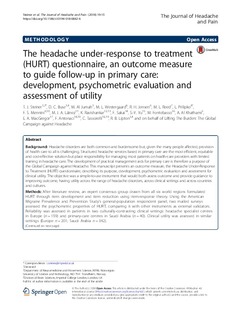| dc.contributor.author | Steiner, Timothy J. | |
| dc.contributor.author | Buse, Dawn C. | |
| dc.contributor.author | Al-Jumah, Mohammed A. | |
| dc.contributor.author | Westergaard, Maria Lurenda S. | |
| dc.contributor.author | Jensen, Rigmor Højland | |
| dc.contributor.author | Reed, Michael L. | |
| dc.contributor.author | Prilipko, Leonid L. | |
| dc.contributor.author | Mennini, Francesco Saverio | |
| dc.contributor.author | Láinez, Miguel J.A. | |
| dc.contributor.author | Ravishankar, Krishnamurthy | |
| dc.contributor.author | Sakai, Fumihiko | |
| dc.contributor.author | Yu, Shengyuan | |
| dc.contributor.author | Fontebasso, Manuela | |
| dc.contributor.author | Al-Khathami, Abdallah Dukhail | |
| dc.contributor.author | MacGregor, E. Anne | |
| dc.contributor.author | Antonaci, Fabio | |
| dc.contributor.author | Tassorelli, Cristina | |
| dc.contributor.author | Lipton, Richard B. | |
| dc.date.accessioned | 2019-04-02T06:02:42Z | |
| dc.date.available | 2019-04-02T06:02:42Z | |
| dc.date.created | 2019-01-24T14:45:04Z | |
| dc.date.issued | 2018 | |
| dc.identifier.citation | The Journal of Headache and Pain. 2018, 19:15 1-9. | nb_NO |
| dc.identifier.issn | 1129-2369 | |
| dc.identifier.uri | http://hdl.handle.net/11250/2592779 | |
| dc.description.abstract | Background
Headache disorders are both common and burdensome but, given the many people affected, provision of health care to all is challenging. Structured headache services based in primary care are the most efficient, equitable and cost-effective solution but place responsibility for managing most patients on health-care providers with limited training in headache care. The development of practical management aids for primary care is therefore a purpose of the Global Campaign against Headache. This manuscript presents an outcome measure, the Headache Under-Response to Treatment (HURT) questionnaire, describing its purpose, development, psychometric evaluation and assessment for clinical utility. The objective was a simple-to-use instrument that would both assess outcome and provide guidance to improving outcome, having utility across the range of headache disorders, across clinical settings and across countries and cultures.
Methods
After literature review, an expert consensus group drawn from all six world regions formulated HURT through item development and item reduction using item-response theory. Using the American Migraine Prevalence and Prevention Study’s general-population respondent panel, two mailed surveys assessed the psychometric properties of HURT, comparing it with other instruments as external validators. Reliability was assessed in patients in two culturally-contrasting clinical settings: headache specialist centres in Europe (n = 159) and primary-care centres in Saudi Arabia (n = 40). Clinical utility was assessed in similar settings (Europe n = 201; Saudi Arabia n = 342).
Results
The final instrument, an 8-item self-administered questionnaire, addressed headache frequency, disability, medication use and effect, patients’ perceptions of headache “control” and their understanding of their diagnoses. Psychometric evaluation revealed a two-factor model (headache frequency, disability and medication use; and medication efficacy and headache control), with scale properties apparently stable across disorders and correlating well and in the expected directions with external validators. The literature review found few instruments linking assessment to clinical advice or suggested actions: HURT appeared to fill this gap. In European specialist care, it showed utility as an outcome measure across headache disorders. In Saudi Arabian primary care, HURT (translated into Arabic) was reliable and responsive to clinical change.
Conclusions
With demonstrated validity and clinical utility across disorders, cultures and settings, HURT is available for clinical and research purposes. | nb_NO |
| dc.language.iso | eng | nb_NO |
| dc.publisher | BioMed Central | nb_NO |
| dc.rights | Navngivelse 4.0 Internasjonal | * |
| dc.rights.uri | http://creativecommons.org/licenses/by/4.0/deed.no | * |
| dc.title | The headache under-response to treatment (HURT) questionnaire, an outcome measure to guide follow-up in primary care: development, psychometric evaluation and assessment of utility | nb_NO |
| dc.type | Journal article | nb_NO |
| dc.type | Peer reviewed | nb_NO |
| dc.description.version | publishedVersion | nb_NO |
| dc.source.pagenumber | 1-9 | nb_NO |
| dc.source.volume | 19:15 | nb_NO |
| dc.source.journal | The Journal of Headache and Pain | nb_NO |
| dc.identifier.doi | 10.1186/s10194-018-0842-6 | |
| dc.identifier.cristin | 1664556 | |
| dc.description.localcode | © The Author(s). 2018. Open Access | nb_NO |
| cristin.unitcode | 194,65,30,0 | |
| cristin.unitname | Institutt for nevromedisin og bevegelsesvitenskap | |
| cristin.ispublished | true | |
| cristin.fulltext | original | |
| cristin.qualitycode | 1 | |

